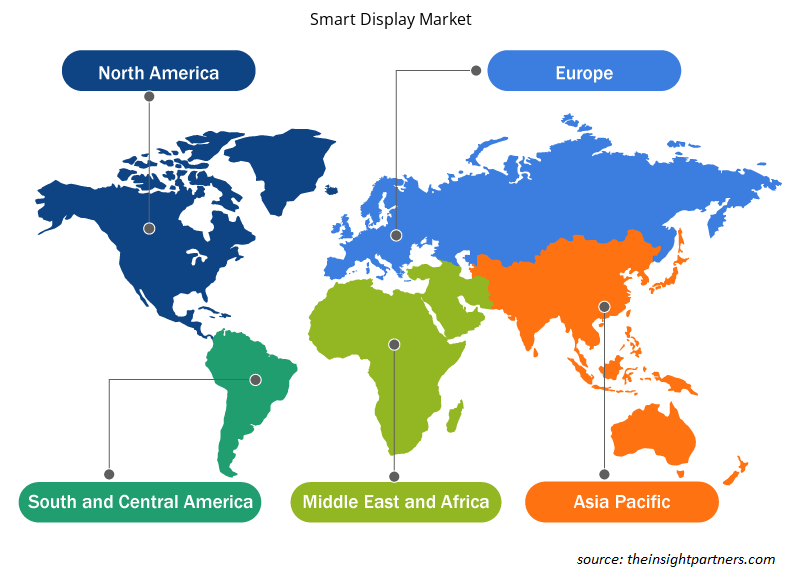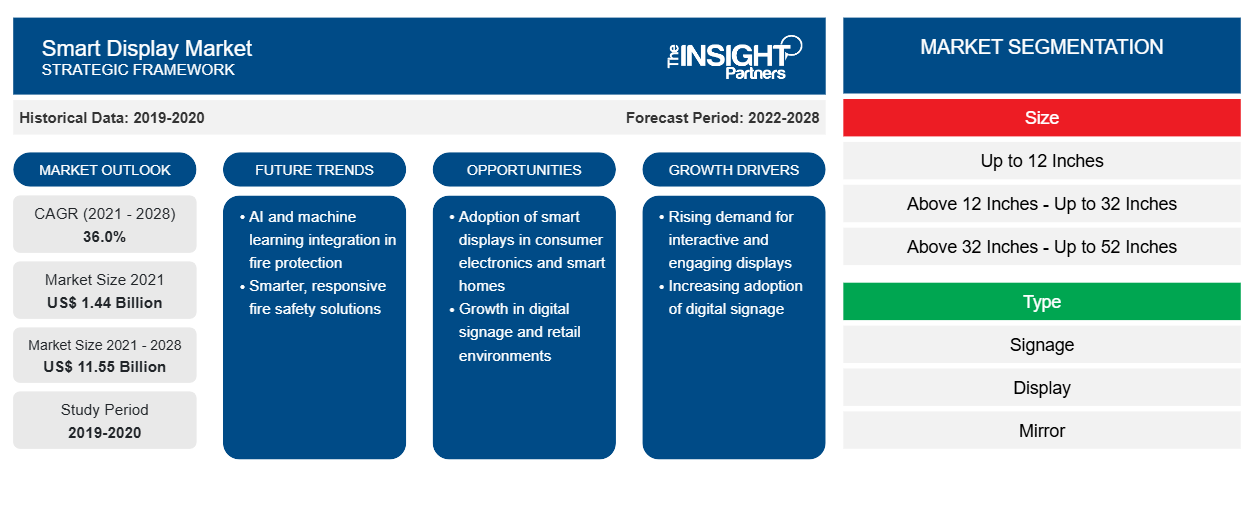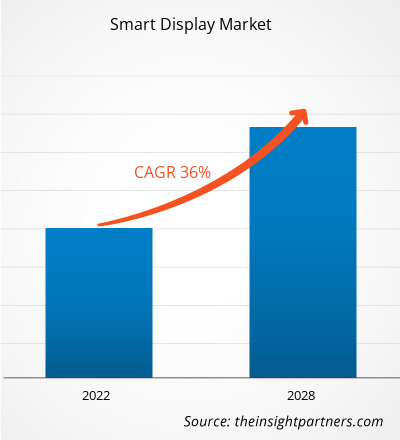El mercado de pantallas inteligentes se valoró en US$ 1.443,74 millones en 2021 y se espera que alcance los US$ 11.547,23 millones en 2028; se estima que registrará una CAGR del 36,0% de 2022 a 2028.
Una pantalla inteligente es una pantalla digital que se puede controlar mediante dispositivos de control remoto por voz o dispositivos conectados a Internet de las cosas (IoT). Por ejemplo, un espejo inteligente es un dispositivo innovador que registra la información personal de los usuarios y la experiencia de compra de los sectores del automóvil y el comercio minorista. Además, como solución técnica de vanguardia, la pantalla inteligente incluye funciones de control interactivas y complejas.
La gran demanda de espejos inteligentes en la industria automotriz, las características nuevas e innovadoras que ofrecen los espejos inteligentes, un número cada vez mayor de usuarios de Internet y la creciente adopción de dispositivos inteligentes según las preferencias de los consumidores, la creciente demanda de electrodomésticos inteligentes impulsados por IA y habilitados para IoT, la creciente tendencia de señalización consciente del contexto y la creciente adopción de señalización inteligente en el sector minorista son los factores impulsores clave que impulsan el crecimiento del mercado de pantallas inteligentes.
El creciente poder adquisitivo de los consumidores sustenta el crecimiento de la industria minorista. Además, la rápida expansión de los centros comerciales y los espacios minoristas en todo el mundo impulsa la demanda de soluciones de señalización inteligente para atraer a los transeúntes y alentarlos a ingresar a la tienda. Como resultado, las tiendas inteligentes están interesadas en utilizar la publicidad programática para aumentar el reconocimiento de la marca. La señalización inteligente también se puede utilizar como parte del proceso de pago. Los clientes pueden pagar utilizando un dispositivo móvil en lugar de hacer cola para pagar. Varios minoristas, como Walmart, Alibaba, Amazon y Carrefour, han establecido tiendas inteligentes en todo el mundo. Utilizan varias soluciones y tecnologías de venta minorista inteligente, como la señalización inteligente, en las tiendas inteligentes. Los minoristas de todo el mundo han implementado estrategias de expansión y asociación para abrir tiendas más inteligentes y sin cajeros. Todos estos factores están impulsando el tamaño del mercado de pantallas inteligentes .
Personalice este informe según sus necesidades
Obtendrá personalización en cualquier informe, sin cargo, incluidas partes de este informe o análisis a nivel de país, paquete de datos de Excel, así como también grandes ofertas y descuentos para empresas emergentes y universidades.
- Obtenga las principales tendencias clave del mercado de este informe.Esta muestra GRATUITA incluirá análisis de datos, desde tendencias del mercado hasta estimaciones y pronósticos.
Perspectivas del mercado de pantallas inteligentes
Presencia de marcas populares
Una vez que los clientes se acostumbran al producto de una marca en particular, compran otros productos de la misma marca. Algunas marcas conocidas, como Google; Amazon, Inc.; Bosch; Panasonic; BenQ Corporation; LG Electronics; Lenovo Group, Ltd.; Samsung Corporation; y Sony Corporation, ofrecen varias soluciones de pantallas inteligentes para las industrias de automóviles, atención médica, residencial y minorista. Estas marcas atraen sin esfuerzo a sus clientes leales y son un factor impulsor importante para el crecimiento del mercado de pantallas inteligentes. Las marcas a veces promocionan sus productos antes del lanzamiento para crear expectación entre los clientes. Por ejemplo, en marzo de 2022, la pantalla inteligente 10 de Xiaomi se incluyó en varios sitios web y el producto se lanzó en abril de 2022. En enero de 2022, Google lanzó su pantalla inteligente Google Nest Hub de segunda generación en la India a US$ 103,24. En junio de 2021, Amazon lanzó 2 nuevos productos de pantalla inteligente en el mercado indio; el Echo Show 10 y 5. Por lo tanto, la creciente popularidad de las marcas está impulsando el crecimiento del mercado de pantallas inteligentes.
Perspectivas del mercado basadas en el tamaño
Según el tamaño, el mercado de pantallas inteligentes se segmenta en hasta 12 pulgadas, por encima de 12 pulgadas, hasta 32 pulgadas, por encima de 32 pulgadas, hasta 52 pulgadas y por encima de 52 pulgadas. Los tamaños de pantalla varían de un fabricante a otro. Mientras que algunos fabricantes ofrecen una mayor funcionalidad incluso en tamaños de pantalla más pequeños, otros prefieren variar la funcionalidad según el tamaño de la pantalla. El mercado está impulsado principalmente por la creciente demanda de pantallas de señalización inteligente de tamaño mediano en varios mercados verticales a nivel mundial.
Perspectivas del mercado basadas en la resolución
Según la resolución, el mercado de pantallas inteligentes se segmenta en Full High Definition (FHD), Ultra High Definition (UHD) y otras. Las pantallas inteligentes con resolución HD se utilizan principalmente para aplicaciones residenciales. Sin embargo, la mayoría de las demás aplicaciones, como la señalización publicitaria o los quioscos inteligentes, utilizan cada vez más pantallas con resoluciones UHD y FHD. El mercado está impulsado principalmente por la creciente demanda de pantallas de señalización inteligente con mejor resolución para que los usuarios puedan disfrutar de una experiencia inmersiva.
Los actores del mercado de pantallas inteligentes adoptan estrategias como fusiones, adquisiciones e iniciativas de mercado para mantener sus posiciones en el mercado. A continuación, se enumeran algunos de los desarrollos de los actores clave del mercado:
- Según NoviSign, líder de la industria y pionero en señalización digital Android, la aplicación de señalización digital Android de NoviSign está actualmente disponible para todas las pantallas profesionales BRAVIA de Sony basadas en Android. La línea profesional BRAVIA de Sony es compatible con 4K y HDR, tiene una plataforma de sistema en un chip y viene en tamaños que van desde las 32 pulgadas hasta las 100 pulgadas.
- BenQ, líder en tecnologías de visualización interactiva, se unió a la Iniciativa de Soluciones Integradas para Educación de Google. El compromiso de BenQ de brindar soluciones educativas que permitan a las escuelas construir entornos de aprendizaje activo más resilientes y adecuados para el aprendizaje presencial y a distancia se mantiene al sumarse a este esfuerzo.
Perspectivas regionales del mercado de pantallas inteligentes
Los analistas de Insight Partners explicaron en detalle las tendencias y los factores regionales que influyen en el mercado de pantallas inteligentes durante el período de pronóstico. Esta sección también analiza los segmentos y la geografía del mercado de pantallas inteligentes en América del Norte, Europa, Asia Pacífico, Oriente Medio y África, y América del Sur y Central.

- Obtenga datos regionales específicos para el mercado de pantallas inteligentes
Alcance del informe sobre el mercado de pantallas inteligentes
| Atributo del informe | Detalles |
|---|---|
| Tamaño del mercado en 2021 | 1.440 millones de dólares estadounidenses |
| Tamaño del mercado en 2028 | US$ 11,55 mil millones |
| CAGR global (2021-2028) | 36,0% |
| Datos históricos | 2019-2020 |
| Período de pronóstico | 2022-2028 |
| Segmentos cubiertos | Por tamaño
|
| Regiones y países cubiertos | América del norte
|
| Líderes del mercado y perfiles de empresas clave |
|
Densidad de actores del mercado: comprensión de su impacto en la dinámica empresarial
El mercado de las pantallas inteligentes está creciendo rápidamente, impulsado por la creciente demanda de los usuarios finales debido a factores como la evolución de las preferencias de los consumidores, los avances tecnológicos y una mayor conciencia de los beneficios del producto. A medida que aumenta la demanda, las empresas amplían sus ofertas, innovan para satisfacer las necesidades de los consumidores y aprovechan las tendencias emergentes, lo que impulsa aún más el crecimiento del mercado.
La densidad de actores del mercado se refiere a la distribución de las empresas o firmas que operan dentro de un mercado o industria en particular. Indica cuántos competidores (actores del mercado) están presentes en un espacio de mercado determinado en relación con su tamaño o valor total de mercado.
Las principales empresas que operan en el mercado de pantallas inteligentes son:
- Alfabeto Inc.
- Amazon.com, Inc.
- Electrónica LG
- GRUPO LENOVO LIMITADO
- Magna Internacional Inc.
Descargo de responsabilidad : Las empresas enumeradas anteriormente no están clasificadas en ningún orden particular.

- Obtenga una descripción general de los principales actores clave del mercado de pantallas inteligentes
El mercado global de pantallas inteligentes está segmentado en función del tamaño, el tipo, la resolución y la industria. Según el tamaño, el mercado se segmenta en hasta 12 pulgadas, por encima de 12 pulgadas, hasta 32 pulgadas, por encima de 32 pulgadas, hasta 52 pulgadas y por encima de 52 pulgadas. En términos de tipo, el mercado se segmenta en señalización, pantalla y espejo. Según la resolución, el mercado se segmenta en alta definición total, ultra alta definición y otros. Además, según la industria, el mercado de pantallas inteligentes se segmenta en electrodomésticos y productos para el hogar, automoción, venta minorista, atención médica y otros.
Alphabet Inc.; Amazon.com, Inc.; LG Electronics; LENOVO GROUP LIMITED; Magna International Inc; Panasonic Corporation; Sony Corporation; BenQ Corporation; NEXCOM International Co., Ltd.; y Samsung Electronics Co., Ltd. son los actores clave del mercado de pantallas inteligentes considerados para el estudio de investigación. Además, en este informe de investigación se han estudiado y analizado varios otros actores importantes del mercado para obtener una visión holística del mercado global de pantallas inteligentes y su ecosistema.
- Análisis histórico (2 años), año base, pronóstico (7 años) con CAGR
- Análisis PEST y FODA
- Tamaño del mercado Valor/volumen: global, regional, nacional
- Industria y panorama competitivo
- Conjunto de datos de Excel



Report Coverage
Revenue forecast, Company Analysis, Industry landscape, Growth factors, and Trends

Segment Covered
This text is related
to segments covered.

Regional Scope
North America, Europe, Asia Pacific, Middle East & Africa, South & Central America

Country Scope
This text is related
to country scope.
Preguntas frecuentes
The adoption of smart signage enables a variety of content to be displayed and scheduled multiple times in a day or week. The context-aware smart signage provides active and real-time information. For instance, it can provide information related to weather; during the rainy season, it can show advertisements for umbrellas, or in summer, it can display advertisements for sunglasses.
The countries that registered a high growth rate during the forecast period are United States, Germany, UK, China, India, and South Korea
Based on type, the smart display market is segmented into display, mirror, and signage. The display segment mostly consists of smart display devices, such as Amazon’s Echo Show and Google’s Nest Max, and automotive smart displays. The growing penetration of IoT and the increasing adoption of smart home products drive market growth.
The top five key players operating in the global smart display market include Amazon, Baidu, Google, Alibaba, and Apple in 2021.
The global market size for smart display market in 2021 is estimated to be $ 1443.74 million.
The driving factors that influence the global smart display market are technological advancements and presence of popular brands.
Trends and growth analysis reports related to Electronics and Semiconductor : READ MORE..
The List of Companies - Smart Display Market
- Alphabet Inc.
- Amazon.com, Inc.
- LG Electronics
- LENOVO GROUP LIMITED
- Magna International Inc
- Panasonic Corporation
- Sony Corporation
- BenQ Corporation
- NEXCOM International Co., Ltd.
- Samsung Electronics Co., Ltd.
The Insight Partners performs research in 4 major stages: Data Collection & Secondary Research, Primary Research, Data Analysis and Data Triangulation & Final Review.
- Data Collection and Secondary Research:
As a market research and consulting firm operating from a decade, we have published and advised several client across the globe. First step for any study will start with an assessment of currently available data and insights from existing reports. Further, historical and current market information is collected from Investor Presentations, Annual Reports, SEC Filings, etc., and other information related to company’s performance and market positioning are gathered from Paid Databases (Factiva, Hoovers, and Reuters) and various other publications available in public domain.
Several associations trade associates, technical forums, institutes, societies and organization are accessed to gain technical as well as market related insights through their publications such as research papers, blogs and press releases related to the studies are referred to get cues about the market. Further, white papers, journals, magazines, and other news articles published in last 3 years are scrutinized and analyzed to understand the current market trends.
- Primary Research:
The primarily interview analysis comprise of data obtained from industry participants interview and answers to survey questions gathered by in-house primary team.
For primary research, interviews are conducted with industry experts/CEOs/Marketing Managers/VPs/Subject Matter Experts from both demand and supply side to get a 360-degree view of the market. The primary team conducts several interviews based on the complexity of the markets to understand the various market trends and dynamics which makes research more credible and precise.
A typical research interview fulfils the following functions:
- Provides first-hand information on the market size, market trends, growth trends, competitive landscape, and outlook
- Validates and strengthens in-house secondary research findings
- Develops the analysis team’s expertise and market understanding
Primary research involves email interactions and telephone interviews for each market, category, segment, and sub-segment across geographies. The participants who typically take part in such a process include, but are not limited to:
- Industry participants: VPs, business development managers, market intelligence managers and national sales managers
- Outside experts: Valuation experts, research analysts and key opinion leaders specializing in the electronics and semiconductor industry.
Below is the breakup of our primary respondents by company, designation, and region:

Once we receive the confirmation from primary research sources or primary respondents, we finalize the base year market estimation and forecast the data as per the macroeconomic and microeconomic factors assessed during data collection.
- Data Analysis:
Once data is validated through both secondary as well as primary respondents, we finalize the market estimations by hypothesis formulation and factor analysis at regional and country level.
- Macro-Economic Factor Analysis:
We analyse macroeconomic indicators such the gross domestic product (GDP), increase in the demand for goods and services across industries, technological advancement, regional economic growth, governmental policies, the influence of COVID-19, PEST analysis, and other aspects. This analysis aids in setting benchmarks for various nations/regions and approximating market splits. Additionally, the general trend of the aforementioned components aid in determining the market's development possibilities.
- Country Level Data:
Various factors that are especially aligned to the country are taken into account to determine the market size for a certain area and country, including the presence of vendors, such as headquarters and offices, the country's GDP, demand patterns, and industry growth. To comprehend the market dynamics for the nation, a number of growth variables, inhibitors, application areas, and current market trends are researched. The aforementioned elements aid in determining the country's overall market's growth potential.
- Company Profile:
The “Table of Contents” is formulated by listing and analyzing more than 25 - 30 companies operating in the market ecosystem across geographies. However, we profile only 10 companies as a standard practice in our syndicate reports. These 10 companies comprise leading, emerging, and regional players. Nonetheless, our analysis is not restricted to the 10 listed companies, we also analyze other companies present in the market to develop a holistic view and understand the prevailing trends. The “Company Profiles” section in the report covers key facts, business description, products & services, financial information, SWOT analysis, and key developments. The financial information presented is extracted from the annual reports and official documents of the publicly listed companies. Upon collecting the information for the sections of respective companies, we verify them via various primary sources and then compile the data in respective company profiles. The company level information helps us in deriving the base number as well as in forecasting the market size.
- Developing Base Number:
Aggregation of sales statistics (2020-2022) and macro-economic factor, and other secondary and primary research insights are utilized to arrive at base number and related market shares for 2022. The data gaps are identified in this step and relevant market data is analyzed, collected from paid primary interviews or databases. On finalizing the base year market size, forecasts are developed on the basis of macro-economic, industry and market growth factors and company level analysis.
- Data Triangulation and Final Review:
The market findings and base year market size calculations are validated from supply as well as demand side. Demand side validations are based on macro-economic factor analysis and benchmarks for respective regions and countries. In case of supply side validations, revenues of major companies are estimated (in case not available) based on industry benchmark, approximate number of employees, product portfolio, and primary interviews revenues are gathered. Further revenue from target product/service segment is assessed to avoid overshooting of market statistics. In case of heavy deviations between supply and demand side values, all thes steps are repeated to achieve synchronization.
We follow an iterative model, wherein we share our research findings with Subject Matter Experts (SME’s) and Key Opinion Leaders (KOLs) until consensus view of the market is not formulated – this model negates any drastic deviation in the opinions of experts. Only validated and universally acceptable research findings are quoted in our reports.
We have important check points that we use to validate our research findings – which we call – data triangulation, where we validate the information, we generate from secondary sources with primary interviews and then we re-validate with our internal data bases and Subject matter experts. This comprehensive model enables us to deliver high quality, reliable data in shortest possible time.


 Obtenga una muestra gratuita de este informe
Obtenga una muestra gratuita de este informe